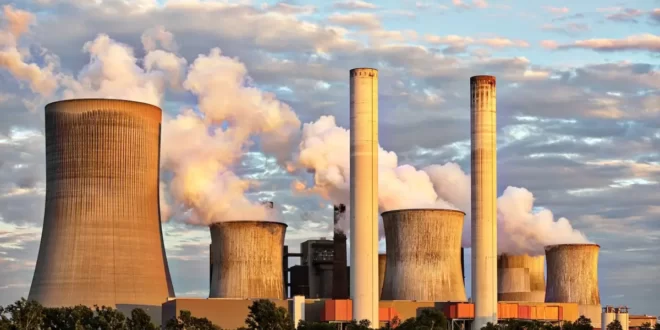There is now a concerted effort to change the global public perception of nuclear power, as governments worldwide look to rapidly expand their clean energy sources to achieve a green transition. Nuclear power has come on a long journey, from widely popular to demonised and back again. But many people remain uncertain about how safe nuclear plants actually are, causing widescale distrust and opposition to the clean energy source. Now, governments and international organisations are once again viewing nuclear power as key to a green future, but will they achieve the popular backing of the public in this assessment?
Under the Paris Agreement and the annual COP climate summits, more and more countries around the globe are striving for decarbonisation. Several governments have committed to the target of net-zero carbon emissions by 2050, intending to shift reliance away from fossil fuels to renewable alternatives. But to achieve these goals, governments must rapidly develop their clean energy sources. Some of the most popular renewable energy projects in development include wind and solar power, hydroelectricity, geothermal energy, and bioenergy. But to provide enough energy to power whole countries requires multiple, vast renewable energy projects, requiring huge amounts of land and sea to develop. In addition, some of these energy sources are unreliable, producing energy only under optimal conditions, such as when the sun is shining.
In comparison to many renewable energy sources, nuclear power is highly stable. In 2020, nuclear power plants produced maximum power more than 92 percent of the time during the year, which was almost 2 times as much as natural gas and coal units, and almost 3 times or more reliable than wind and solar plants.Until battery storage becomes more widely developed, nuclear power will continue to be the most consistent provider of clean energy, making it highly effective for a green transition. Further, the average nuclear plant produces a huge 1 GW of electricity. And you cannot simply replace nuclear plants with fossil fuel or renewable energy equivalents and expect the same output. It would require almost two coal or three to four renewable plants (each of 1 GW size) to generate the same amount of electricity onto the grid.
In a world striving for a green transition, it is clear why nuclear power is seen as key to decarbonisation, and yet governments worldwide are having to challenge the poor public perception of nuclear power to get new projects off the ground. This perception has been driven by disasters of the past, albeit big ones, such as Chornobyl, Fukushima and Three Mile Island. It has been further exacerbated by campaigns by major environmental organisations such as Greenpeace, which continues to believe that nuclear power has “no place in a safe, clean, sustainable future.” But many of the arguments against nuclear power are stuck in the past.
Meanwhile, the International Atomic Energy Agency says nuclear power plants are among “the safest and most secure facilities in the world.” They must adhere to stringent international safety standards. Training and best practices have also become stricter and more internationally standardised in recent decades, further enhancing security. In addition, nuclear waste storage facilities are highly protected against earthquakes, tornadoes, and other potential disasters.
While safety is a major question, it is also important that the public understand the alternative. Many believe that nuclear energy is the only reasonable replacement for fossil fuels on such as wide scale. Michael Shellenberger, the founder of the environmental organisation Environmental Progress, asked “How do you provide cheap, reliable and pollution-free energy for a world of 8 billion people?” He believes, “Nuclear energy is really the only scalable version of that, renewables are not reliable.”
And he’s not the only one with this view. Governments worldwide are beginning to pump funding into nuclear energy once again. A recent Schroders report showed that there are 486 nuclear reactors either planned, proposed or under construction, which could provide a combined 65.9 billion watts of electric capacity. This is a huge turnaround considering the International Energy Agency 2019 warning of a “future decline” in nuclear power.
Consider that nuclear power is more reliable and provides more energy than your average renewable energy, this would mean that ongoing reliance on fossil fuels would be the only reasonable alternative to nuclear power. However, nuclear power is significantly safer than coal, oil, and gas operations. Experts believe air pollution from fossil fuels is responsible for an estimated 7 million deaths per year, nuclear energy carries a similar level of risk as wind power and is around 350 times safer than coal. Per terawatt-hour of energy production, coal is thought to cause 24.6 deaths, oil 18.4 deaths, natural gas 2.8 deaths and nuclear energy 0.07 deaths. Meanwhile, per gigawatt-hour of electricity over the lifecycle of the power plant, coal production emits around 820 tonnes of CO2, oil 720 tonnes, gas 490 tonnes and nuclear energy just 3 tonnes – lower than that of both wind and solar power.
As we strive for a global green transition, it seems that nuclear power is here to stay. Nuclear plants can provide safe, reliable, low-carbon energy on a vast scale, making them highly popular with governments aiming to rapidly decarbonise and reduce reliance on fossil fuels. And while the current public perception of the energy source remains mainly negative or uncertain, analyses demonstrate that nuclear power is one of the safest and least-polluting forms of energy. Governments and international organisations worldwide must now focus on changing this public perception to gain support for the clean energy source and ensure its place in the future.

 Iran Energy News Oil, Gas, Petrochemical and Energy Field Specialized Channel
Iran Energy News Oil, Gas, Petrochemical and Energy Field Specialized Channel



